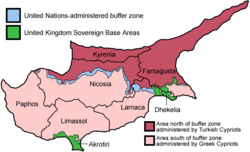This article needs additional citations for verification .(December 2011) |

A demilitarized zone (DMZ or DZ) [1] is an area in which treaties or agreements between states, military powers or contending groups forbid military installations, activities, or personnel. A DZ often lies along an established frontier or boundary between two or more military powers or alliances. A DZ may sometimes form a de facto international border, such as the Korean Demilitarized Zone. Other examples of demilitarized zones are a 14 km (8.7 mi) wide area between Iraq and Kuwait; Antarctica (preserved for scientific exploration and study); and outer space (space more than 100 km or 62 mi from the Earth's surface).
Contents
Some zones remain demilitarized after an agreement has awarded control to a state which (under the DZ terms) had originally ceded its right to maintain military forces in the disputed territory. It is also possible for powers to agree on the demilitarization of a zone without formally settling their respective territorial claims, enabling the dispute to be resolved by peaceful means such as diplomatic dialogue or an international court.
Several demilitarized zones have also unintentionally become wildlife preserves because their land is unsafe for construction or less exposed to human disturbances (including hunting). Examples include the Korean Demilitarized Zone, the Cypriot Demilitarized Zone (the Green Line), and the former Vietnamese Demilitarized Zone which divided Vietnam into two countries (North Vietnam and South Vietnam) from 21 July 1954 to 2 July 1976.




